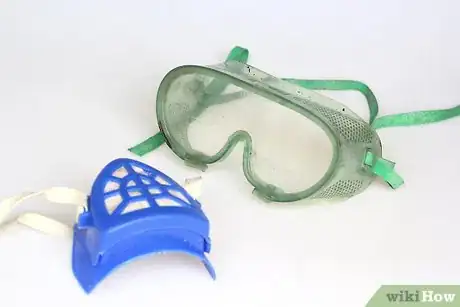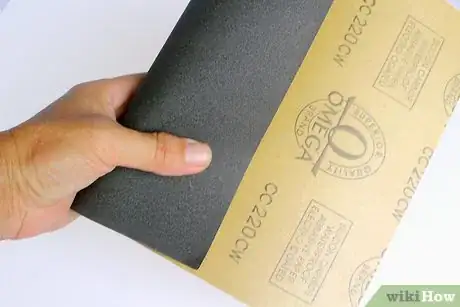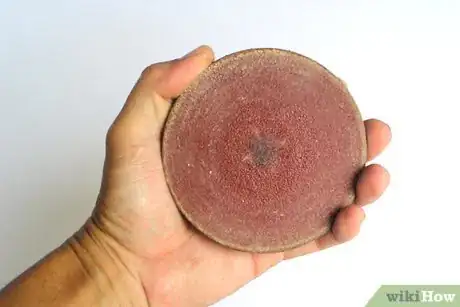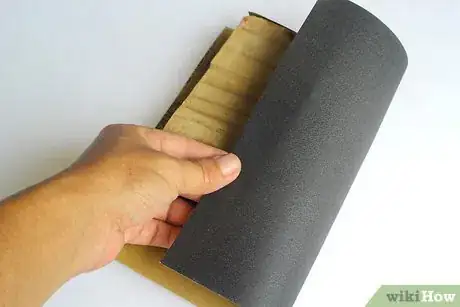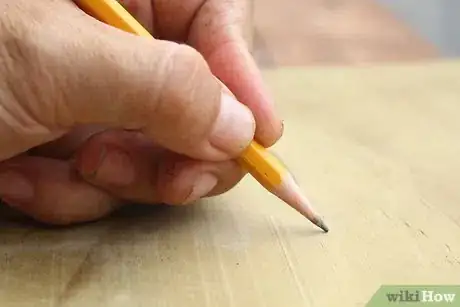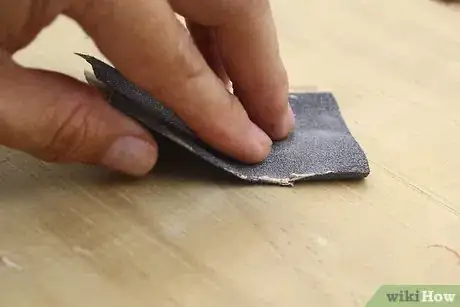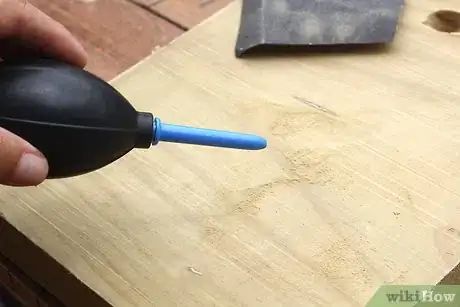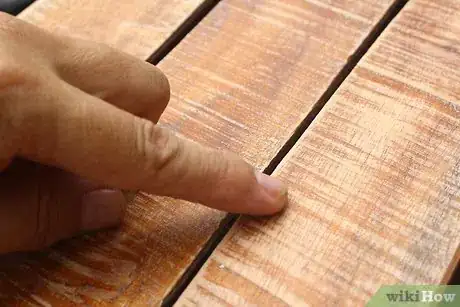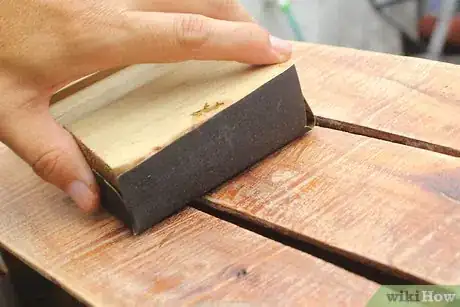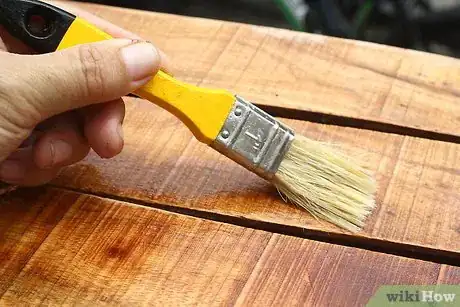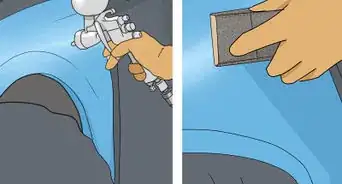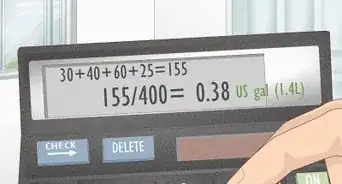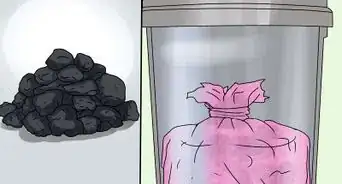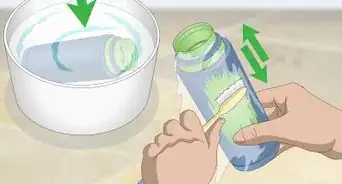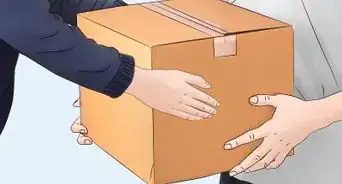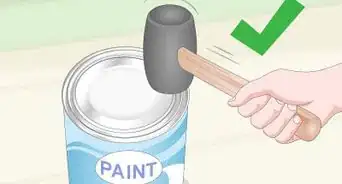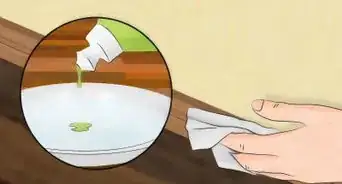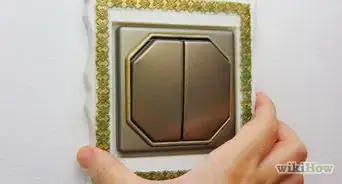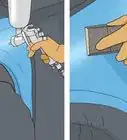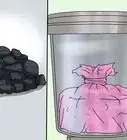This article was co-authored by Varga Gulshani. Varga Gulshani is a Residential Painting Specialist and the Owner of Elegant Painting based in Washington. With more than 16 years of experience, Varga and his team specialize in residential interior painting, exterior painting, and cabinet painting. Varga and the Elegant Painting team have all received background and verification checks.
There are 10 references cited in this article, which can be found at the bottom of the page.
This article has been viewed 51,824 times.
Scuff sanding is the process of lightly sanding a surface in preparation for primer, paint, and/or varnish.[1] You can scuff sand bare surfaces, or even ones that have been already painted or varnished. It helps smooth out imperfections as well as give paint and varnish something to grip on to. There is a trick to doing it just right, however; you have to use a fine grit and a light touch.[2]
Steps
Getting Ready to Sand
-
1Put on a pair of goggles and a dust mask. If possible, move to a well-ventilated area, or at the very least, open up a window. Sanding creates a lot of dust. Some surfaces contain coatings (i.e.: polyurethane) that can be hazardous to your health and lungs.[3]
- If you are going to scuff sand walls, check to see that the paint does not contain lead. If the paint contains lead, do not sand it; use a de-glosser instead.[4]
-
2Choose a fine-grit sandpaper. There are lots of different grits that fall into this category, so choose something based on the type of scuffing you are doing. In most cases, you will scuff sand a bare surface before applying anything, and sand again between coats of paint or sealer. Here is what you should look for:[5]
- If you are scuffing bare wood, or another surface, in preparation for priming, painting, and/or staining, you will need something between P120 and P150.
- If you are scuffing between coats of paint or sealer, choose something between P180 and P220.
- If you are sanding between coats of varnish and need a high-gloss finish, look for a P320 grit.[6]
- For high-gloss varnish, polyurethane, and lacquer finishes, wet sand with P600 or P800.
Advertisement -
3Consider other options besides sandpaper. There are buff sanders, sanding blocks, and sanding sponges. A piece of sandpaper or a sanding block will be suitable for most surfaces, but it may not be the most efficient for curves or tight corners. Here are some options you should consider:[7]
- Floors: Buffer and sandpaper.[8]
- Rounded curve: use a sanding sponge.
- Tight corners: choose a sander with a pointed tip or a fine wire brush.
- Steel wool comes in a variety of grades and can be used in place of sandpaper.
- Sandpaper and finish sanders are always your best bet, especially when compared to liquid sanders.[9]
-
4Fold or wrap the sandpaper, if necessary. A flat sheet of sandpaper will work just fine on flat surfaces, but there are a few things you can do to make it even more efficient, based on the job that you are doing. Here are a few suggestions:
- Small items or corners: cut a sheet of sandpaper into quarters, then fold each quarter into thirds, lengthwise.[10]
- Concave curve: wrap the sandpaper around a 1-inch (2.54-centimeter) wide dowel.[11] Secure it with double-sided tape or glue.
- Walls: attach your sandpaper or sanding block to a pole. You can find special attachments in a hardware store.[12]
Scuff Sanding the Surface
-
1Consider marking up bare surfaces with a pencil. You don't absolutely have to do this, but it is a good way to judge how much you've sanded. Use a pencil to draw squiggles on the surface to be sanded.
-
2Lightly sand the surface. Use a light touch and do not press down too hard, otherwise, you will get scratches in your work. If you see scratches, wet the surface and use a lighter touch or switch to a finer grit.[13] Always work with the grain, not against it, and do no more than three passes on edges and corners.
- If you are sanding a floor, sand the entire floor with a buffer. Go with the grain, and overlap each row by 6 inches (15.24 centimeters).[14]
-
3Clean the dust off of your work. Dust small pieces off with a dry paintbrush first, then wipe it clean with a tack cloth. If the piece is especially dusty, wipe it down with a damp cloth instead, then let it dry completely.[15] [16] Clean larger pieces with a vacuum or an air hose first, then wipe them down with a tack cloth as well.[17] [18]
-
4Check the surface for un-sanded patches. A painted or primed surface is the easiest to tell, because it will look chalky. Other surfaces, such as bare wood or varnished surfaces, may be harder to tell. Run one hand over the surface and sand out any areas you missed with the other. Here are some tips:
-
5Re-sand the surface, if needed, then wipe it clean again. You may have to do this a few times until you achieve the finish you want. Bare wood surfaces should feel smooth, without any snags. Primed or painted surfaces should look chalky, while varnished surfaces should look matte.
- Do not over-sand, especially for primed, painted, or varnished surfaces. You do not want to sand through to the bare surface.
- If you are sanding a floor, go back along the edges with 180-grit sandpaper, 4 to 6 inches (10.16 to 15.24 centimeters) from the baseboards.[23]
-
6Apply your paint and/or varnish as usual. If you are working with just varnish, consider sanding between the different coats of varnish as well; be sure to let each coat dry first, however. You could also apply two coats of varnish before scuff sanding it. The first coat will fill in any gaps, while the second will smooth things out.[24]
Expert Q&A
-
QuestionHow do I clean up after scuff sanding?
 Varga GulshaniVarga Gulshani is a Residential Painting Specialist and the Owner of Elegant Painting based in Washington. With more than 16 years of experience, Varga and his team specialize in residential interior painting, exterior painting, and cabinet painting. Varga and the Elegant Painting team have all received background and verification checks.
Varga GulshaniVarga Gulshani is a Residential Painting Specialist and the Owner of Elegant Painting based in Washington. With more than 16 years of experience, Varga and his team specialize in residential interior painting, exterior painting, and cabinet painting. Varga and the Elegant Painting team have all received background and verification checks.
Residential Painting Specialist You should extract the dust using vacuum extractors. Then, wipe everything down with either a tack cloth or a clean microfiber cloth. Finally, use a small blower to remove any lint and you are ready to prime or paint.
You should extract the dust using vacuum extractors. Then, wipe everything down with either a tack cloth or a clean microfiber cloth. Finally, use a small blower to remove any lint and you are ready to prime or paint. -
QuestionWill this process work on veneer surfaces?
 ZackTop AnswererYes, you can scuff sand veneer if you are cautious. Use extremely fine sandpaper, and try to remove as little material as possible so that you do not sand through the veneer. Easy does it.
ZackTop AnswererYes, you can scuff sand veneer if you are cautious. Use extremely fine sandpaper, and try to remove as little material as possible so that you do not sand through the veneer. Easy does it.
Warnings
- Always wear protective goggles over your eyes.[28]⧼thumbs_response⧽
- Always wear a dust mask or respirator so that you don't breathe in the sanding dust.[29]⧼thumbs_response⧽
- Be careful when using an extension pole. Steer clear of power lines and other electrical hazards.[30]⧼thumbs_response⧽
- Do not sand surfaces containing lead paint. Use a de-glosser instead.[31]⧼thumbs_response⧽
Things You'll Need
- Tack cloth
- 140 to 220-grit sandpaper
References
- ↑ Varga Gulshani. Residential Painting Specialist. Expert Interview. 12 January 2021.
- ↑ http://www.woodweb.com/knowledge_base/The_Fine_Points_of_Scuff_Sanding.html
- ↑ http://www.southernliving.com/home-garden/solutions/paint-pro-secret-paper-sanding
- ↑ https://www.familyhandyman.com/painting/tips/professional-painting-tips/view-all
- ↑ http://gatorfinishing.com/sanding101
- ↑ http://www.woodworkingnetwork.com/production-woodworking/wood-finishing-sanding/Applying-Scruff-Sanding-Correctly-148945895.html
- ↑ http://www.southernliving.com/home-garden/solutions/paint-pro-secret-paper-sanding
- ↑ https://www.thisoldhouse.com/how-to/how-to-refinish-wood-floors
- ↑ Varga Gulshani. Residential Painting Specialist. Expert Interview. 12 January 2021.
- ↑ http://www.woodworkingnetwork.com/production-woodworking/wood-finishing-sanding/Applying-Scruff-Sanding-Correctly-148945895.html
- ↑ http://www.southernliving.com/home-garden/solutions/paint-pro-secret-paper-sanding
- ↑ https://www.youtube.com/watch?v=79qqGwDF10Q
- ↑ http://www.southernliving.com/home-garden/solutions/paint-pro-secret-paper-sanding
- ↑ https://www.thisoldhouse.com/how-to/how-to-refinish-wood-floors
- ↑ http://www.southernliving.com/home-garden/solutions/paint-pro-secret-paper-sanding
- ↑ Varga Gulshani. Residential Painting Specialist. Expert Interview. 12 January 2021.
- ↑ http://www.woodworkingnetwork.com/production-woodworking/wood-finishing-sanding/Applying-Scruff-Sanding-Correctly-148945895.html
- ↑ Varga Gulshani. Residential Painting Specialist. Expert Interview. 12 January 2021.
- ↑ https://www.thisoldhouse.com/how-to/how-to-refinish-wood-floors
- ↑ https://www.youtube.com/watch?v=79qqGwDF10Q
- ↑ http://www.southernliving.com/home-garden/solutions/paint-pro-secret-paper-sanding
- ↑ http://www.woodworkingnetwork.com/production-woodworking/wood-finishing-sanding/Applying-Scruff-Sanding-Correctly-148945895.html
- ↑ https://www.thisoldhouse.com/how-to/how-to-refinish-wood-floors
- ↑ http://www.woodweb.com/knowledge_base/The_Fine_Points_of_Scuff_Sanding.html
- ↑ http://www.woodworkingnetwork.com/custom-woodworking/wood-finishing/Why--How-Do-You-Scuff-Sand-148099465.html
- ↑ http://www.woodworkingnetwork.com/custom-woodworking/wood-finishing/Why--How-Do-You-Scuff-Sand-148099465.html
- ↑ http://www.woodworkingnetwork.com/custom-woodworking/wood-finishing/Why--How-Do-You-Scuff-Sand-148099465.html
- ↑ https://www.youtube.com/watch?v=dqNPRg1Glv8
- ↑ https://www.youtube.com/watch?v=dqNPRg1Glv8
- ↑ https://www.youtube.com/watch?v=dqNPRg1Glv8
- ↑ https://www.familyhandyman.com/painting/tips/professional-painting-tips/view-all

